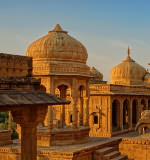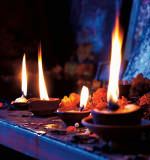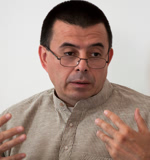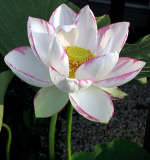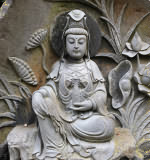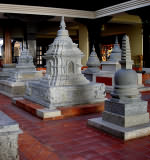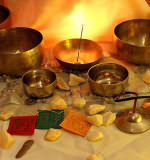| Download and install the indispensable font(s) to view Sanskrit in its full glory Read Transliterating (2) (English) to fully understand the transliteration system |
Tantrasāra (Tantrasara): Chapter 13
Samayidīkṣāprakāśanam - Explaining the initiation into discipline [for beginners]
Introduction
This is the thirteenth chapter (called Samayidīkṣāprakāśanam).
This work was written by the great Master Abhinavagupta and is a summary of Tantrāloka. Tantrāloka is the most important and voluminous work of the greatest Trika Master. Abhinavagupta was also the teacher of eminent Kṣemarāja and lived about 975-1025 AD in Kashmir.
This treatise whose name is Tantrasāra is a summarized encyclopedia of Tantra. Since it is a very advanced text in Trika Shaivism, there is no surprise if a neophyte finds it difficult to understand. To start to understand it, the level of the reader must be the one of a real disciple in Trika Shaivism. If this requirement is not met, then there will be a lot of confusion and constant disappointment. Because in spite of my great efforts to explain the things so easily as possible, to study this treatise requires some spiritual caliber. In this system, sometimes it is not possible even to write about certain topics due to the extreme limitation of the words. Because in the end, all this knowledge has to do with 'states', and it is extremely difficult to write about 'states' in a precise way. Abhinavagupta has done his best to accomplish this formidable task of writing about what is superior and intangible. Anyway, despite his incredible skills to carry out this, he is not revealing everything. It is not because he is all the time hiding things from the reader, but because he is sometimes hiding and on other occasions he just cannot write about some extremely subtle topics because of the limitation of the words.
Goal of life is Liberation. Man has searched for freedom always in human history, but according to Trika Shaivism that is not real Liberation. Real Liberation does not mean that your body should be free from some prison and things like that. Real Liberation amounts to attaining His Svātantrya or Absolute Freedom. When the Great Lord's Svātantrya is achieved, then you see unity in all the things, i.e. you stop seeing duality as before. All is forever identified with Svātantrya, with Him, and that is the end of the story called 'you in bondage'. From this point on nothing will get in your way, because if something apparently gets in your way, that is Svātantrya again. This constant awareness of unity in all is real Freedom. There is no other attainment greater than this!
Keeping the above in mind, now read Tantrasāra and experience Supreme Delight, dear Śiva.
Important: All that is in brackets and italicized within the translation has been added by me in order to complete the sense of a particular phrase or sentence. In turn, all that is between double hyphen (--...--) constitutes clarifying further information also added by me.
Chapter 13
तन्त्रसारः
त्रयोदशमाह्निकम्
अथ प्रसन्नहृदयो यागस्थानं यायात्तच्च यत्रैव हृदयं प्रसादयुक्तं परमेश्वरसमावेशयोग्यं भवति तदेव न त्वस्यान्यल्लक्षणमुक्तावपि ध्येयतादात्म्यमेव कारणं तदपि भावप्रसादादेवेति नान्यत्स्थानम्। पीठपर्वताग्रमित्यादिस्तु शास्त्रे स्थानोद्देश एतत्पर एव बोद्धव्यः - तेषु तेषु पीठादिस्थानेषु परमेशनियत्या परमेश्वराविष्टानां शक्तीनां देहग्रहणादार्यदेशा इव धार्मिकाणां म्लेच्छदेशा इवाधार्मिकाणां पर्वताग्रादेश्चैकान्तत्वेन विक्षेपपरिहारादैकाग्र्यपदत्वमिति। तत्र यागगृहाग्रे बहिरेव सामान्यन्यासं कुर्यात्करयोः पूर्वं ततो देहे। ह्रीं-न-फ-ह्रीं ह्रीं-आ-क्ष-ह्रीं इत्याभ्यां शक्तिशक्तिमद्वाचकाभ्यां मालिनीशब्दराशिमन्त्राभ्यामेकेनैवादौ शक्तिस्ततः शक्तिमानिति मुक्तौ पादाग्राच्छिरोऽन्तं भुक्तौ तु सर्वो विपर्ययः। मालिनी हि भगवती मुख्यं शाक्तं रूपं बीजयोनिसङ्घट्टेन समस्तकामदुघम्। अन्वर्थं चैतन्नाम रुद्रशक्तिमालाभिर्युक्ता फलेषु पुष्पिता संसारशिशिरसंहारनादभ्रमरी सिद्धिमोक्षधारिणी दानादानशक्तियुक्तेति र-लयोरेकत्वस्मृतेः। अत एव हि भ्रष्टविधिरपि मन्त्र एतन्न्यासात्पूर्णो भवति साञ्जनोऽपि गारुडवैष्णवादिर्निरञ्जनतामेत्य मोक्षप्रदो भवति। देहन्यासानन्तरमर्घपात्रेऽयमेव न्यासः। इह हि क्रियाकारकाणां परमेश्वराभेदप्रतिपत्तिदार्ढ्यसिद्धये पूजाक्रिया उदाहरणीकृता तत्र च सर्वकारकाणामित्थं परमेश्वरीभावस्तत्र यष्ट्राधारस्य स्थानशुद्ध्योपादानकरणयोरर्घपात्रशुद्धिन्यासाभ्यां यष्टुर्देहन्यासाद्याज्यस्य स्थण्डिलादिन्यासात्। एवं क्रियाक्रमेणापि परमेश्वरीकृतसमस्तकारकस्तयैव दृशा सर्वक्रियाः पश्यन्विनापि प्रमुखज्ञानयोगाभ्यां परमेश्वर एव भवति। एवमर्घपात्रे न्यस्य पुष्पधूपाद्यैः पूजयित्वा तद्विप्रुड्भिर्यागसारं पुष्पादि च प्रोक्षयेत्। ततः प्रभामण्डले भूमौ खे वा ॐ-बाह्यपरिवाराय नम इति पूजयेत्। ततो द्वारस्थाने ॐ-द्वारदेवताचक्राय नम इति पूजयेत्। अगुप्ते तु बहिःस्थाने सति प्रविश्य मण्डलस्थण्डिलाग्र एव बाह्यपरिवारद्वारदेवताचक्रपूजां पूर्वोक्तं च न्यासादि कुर्यान्न बहिः। ततोऽपि फट् फट् फट् इत्यस्त्रजप्तपुष्पं प्रक्षिप्य विघ्नानपसारितान्ध्यात्वान्तः प्रविश्य परमेश्वरकिरणेद्धया दृष्ट्याभितो यागगृहं पश्येत्। तत्र मुमुक्षुरुत्तराभिमुखस्तिष्ठेद्यथा भगवदघोरतेजसा झटित्येव प्लुष्टपाशो भवेत्। तत्र परमेश्वरस्वातन्त्र्यमेव मूर्त्याभासनया दिक्तत्त्वमवभासयति। तत्र चित्प्रकाश एव मध्यं तत इतरप्रविभागप्रवृत्तेः प्रकाशस्वीकार्यमूर्ध्वमतथाभूतमधः प्रकाशनसम्मुखीनं पूर्वमितरदपरं सम्मुखीभूतप्रकाशत्वादनन्तरं तत्प्रकाशधारारोहस्थानं दक्षिणमानुकूल्यात्तत्सम्मुखं त्ववभास्यत्वादुत्तरमिति दिक्चतुष्कम्। तत्र मध्ये भगवानूर्ध्वेऽस्यैशानं वक्त्रमधः पातालवक्त्रं पूर्वादिदिक्चतुष्के श्रीतत्पुरुषाघोरसद्योवामाख्यं दिक्चतुष्कमध्येऽन्याश्चतस्रः - इत्येवं संविन्महिमैव मूर्तिकृतं दिग्भेदं भासयतीति दिग् न तत्त्वान्तरम्। यथा यथा च स्वच्छाया लङ्घयितुमिष्टा सती पुरः पुरो भवति तथा परमेश्वरमध्यतामेति सर्वाधिष्ठातृतैव माध्यस्थ्यमित्युक्तम्। एवं यथा भगवान्दिग्विभागकारी तथा सूर्योऽपि स हि पारमेश्वर्येव ज्ञानशक्तिरित्युक्तं तत्र तत्र तत्र पूर्वं व्यक्तेः पूर्वा यत्रैव च तथा तत्रैवैवं स्वात्माधीनापि स्वसम्मुखीनस्य देशस्य पुरस्तात्त्वात्। एवं स्वात्मसूर्यपरमेशत्रितयैकीभावनया दिक्चर्चेत्यभिनवगुप्तगुरवः। एवं स्थित उत्तराभिमुखमुपविश्य देहपुर्यष्टकादावहम्भावत्यागेन देहतां दहेत्सन्निधावपि परदेहवत् - अदेहत्वात् ततो निस्तरङ्गध्रुवधामरूढस्य दृष्टिस्वाभाव्याद्या किलाद्या स्पन्दकला सैव मूर्तिस्तदुपरि यथोपदिष्टयाज्यदेवताचक्रन्यासः प्राधान्येन चेह शक्तयो याज्याः - तदासनत्वाद्भगवन्नवात्मादीनां शक्तेरेव च पूज्यत्वादिति गुरवः। तत्र च पञ्च अवस्था जाग्रदाद्याः षष्ठी चानुत्तरा नाम स्वभावदशा अनुसन्धेया - इति षोढा न्यासो भवति। तत्र कारणानां ब्रह्मविष्णुरुद्रेशसदाशिवशक्तिरूपाणां प्रत्येकमधिष्ठानात्षट्त्रिंशत्तत्त्वकलापस्य लौकिकतत्त्वोत्तीर्णस्य भैरवभट्टारकाभेदवृत्ते न्यासे पूर्णत्वाद्भैरवीभावस्तेनैतदनवकाशम्। यदाहुरतरङ्गरूढौ लब्धायां पुनः किं तत्त्वसृष्टिन्यासादिनेति। तावद्धि तदतरङ्गं भैरववपुर्यत् स्वात्मन्यवभासितसृष्टिसंहारवैचित्र्यकोटि। एवमन्योन्यमेलकयोगेन परमेश्वरीभूतं प्राणदेहबुद्ध्यादि भावयित्वा बहिरन्तः पुष्पधूपतर्पणाद्यैर्यथासम्भवं पूजयेत्। तत्र शरीरे प्राणे धियि च तदनुसारेण शूलाब्जन्यासं कुर्यात्तद्यथा - आधारशक्तिमूले मूलं कन्द आमूलसारकं लम्बिकान्ते कलातत्त्वान्तो दण्डो मायात्मको ग्रन्थिश्चतुष्किकात्मा शुद्धविद्यापद्मं तत्रैव सदाशिवभट्टारकः स एव महाप्रेतः - प्रकर्षेण लीनत्वाद्बोधात्प्राधान्येन वेद्यात्मकदेहक्षयान्नादामर्शात्मकत्वाच्चेति। तन्नाभ्युत्थितं तन्मूर्धरन्ध्रत्रयनिर्गतं नादान्तर्वर्तिशक्तिव्यापिनीसमनारूपमरत्रयं द्विषट्कान्तं तदुपरि शुद्धपद्मत्रयमौन्मनसमेतस्मिन्विश्वमये भेद आसनीकृतेऽधिष्ठातृतया व्यापकभावेनाधेयभूतां यथाभिमतां देवतां कल्पयित्वा यत्तत्रैव समस्वभावनिर्भरात्मनि विश्वभावार्पणं तदेव पूजनं यदेव तन्मयीभवनं तद् ध्यानं यत् तथाविधान्तःपरामर्शसद्भावनादान्दोलनं स जपो यत् तथाविधपरामर्शक्रमप्रबुद्धमहातेजसा तथाबलादेव विश्वात्मीकरणं स होमस्तदेवं कृत्वा परिवारं तत एव वह्निराशेर्विस्फुलिङ्गवद्ध्यात्वा तथैव पूजयेत्।
द्वादशान्तमिदं प्राग्रं त्रिशूलं मूलतः स्मरन्।
देवीचक्राग्रगं त्यक्तक्रमः खेचरतां व्रजेत्॥
मूलाधाराद्द्विषट्कान्तव्योमाग्रापूरणात्मिका।
खेचरीयं खसञ्चारस्थितिभ्यां खामृताशनात्॥
एवमन्तर्यागमात्रादेव वस्तुतः कृतकृत्यता। सत्यतस्तदाविष्टस्य तथापि बहिरपि कार्यो यागोऽवच्छेदहानय एव योऽपि तथा समावेशभाग्न भवति तस्य मुख्यो बहिर्यागस्तदभ्यासात्समावेशलाभः - यतस्तस्यापि तु पशुतातिरोधानायान्तर्यागः - तदरूढावपि तत्सङ्कल्पबलस्य शुद्धिप्रदत्वात्। अथ यदा दीक्षां चिकीर्षेत्तदाधिवासनार्थं भूमिपरिग्रहं गणेशार्चनं कुम्भकलशयोः पूजां स्थण्डिलार्चनं हवनं च कुर्यात्। नित्यनैमित्तिकयोस्तु स्थण्डिलाद्यर्चनहवन एव। तत्राधिवासनं शिष्यस्य संस्कृतयोग्यताधानमम्ब्लीकरणमिव दन्तानां देवस्य कर्तव्योन्मुखत्वग्राहणं गुरोस्तद्ग्रहणम्। उपकरणद्रव्याणां यागगृहान्तर्वर्तितया परमेशतेजोबृंहणेन पूजोपकरणयोग्यतार्पणमिति। तत्र सर्वोपकरणपूर्णं यागगृहं विधाय भगवतीं मालिनीं मातृकां वा स्मृत्वा तद्वर्णतेजःपुञ्जभरितं गृहीतं भावयन्पुष्पाञ्जलिं क्षिपेत्। तत उक्तास्त्रजप्तानि यथासम्भवं सिद्धार्थधान्याक्षतलाजादीनि तेजोरूपाणि विकीर्य ऐशान्यां दिशि क्रमेण सङ्घट्टयेदिति भूपरिग्रहः। ततः शुद्धविद्यान्तमासनं दत्त्वा गणपतेः पूजा ततः कुम्भमानन्दद्रव्यपूरितमलङ्कृतं पूजयेत्ततो याज्यमनु पूगं न्यस्य तत्र मुख्यं मन्त्रं सर्वाधिष्ठातृतया विधिपूर्वकत्वेन स्मरन् अष्टोत्तरशतमन्त्रितं तेन तं कुम्भं कुर्यात्। द्वितीयकलशे विघ्नशमनायास्त्रं यजेत्। ततः स्वस्वदिक्षु लोकपालान्सास्त्रान्पूजयेत्। ततः शिष्यस्य प्राक् दीक्षितस्य हस्तेऽस्त्रकलशं दद्यात्। स्वयं च गुरुः कुम्भमाददीत। ततः शिष्यं गृहपर्यन्तेषु विघ्नशमनाय धारां पातयन्तं सकुम्भोऽनुगच्छेदिमं मन्त्रं पठन्-
भो भोः शक्र त्वया स्वस्यां दिशि विघ्नप्रशान्तये।
सावधानेन कर्मान्तं भवितव्यं शिवाज्ञया॥
त्र्यक्षरे नाम्नि - भो इत्येकमेव। तत ऐशान्यां दिशि कुम्भं स्थापयेत्। विकिरोपरि अस्त्रकलशम्। तत उभयपूजनम्। ततः स्थण्डिलमध्ये परमेशपूजनम्। ततोऽग्निकुण्डं परमेश्वरशक्तिरूपतया भावयित्वा तत्राग्निं प्रज्वाल्य हृदयान्तर्बोधाग्निना सहैकीकृत्य मन्त्रपरामर्शसाहित्येन ज्वलन्तं शिवाग्निं भावयित्वा तत्र न्यस्याभ्यर्च्य मन्त्रान्तर्पयेदाज्येन तिलैश्च। अर्घपात्रेण च प्रोक्षणमेव तिलाज्यादीनां संस्कारः। स्रुक्स्रुवयोश्च परमेशाभेददृष्टिरेव हि संस्कारः। ततो यथाशक्ति हुत्वा स्रुक्स्रुवावूर्ध्वाधोमुखतया शक्तिशिवरूपौ परस्परोन्मुखौ विधाय समपादोत्थितो द्वादशान्तगगनोदितशिवपूर्णचन्द्रनिःसृतपतत्परामृतधाराभावनां कुर्वन्वौषडन्तं मन्त्रमुच्चारयंश्चाज्यक्षयान्तं तिष्ठेदिति पूर्णाहुतिर्मन्त्रचक्रसन्तर्पणी। ततश्चरुं प्रोक्षितमानीय स्थण्डिलकलशकुम्भवह्निषु भागं भागं निवेद्यैकभागमवशेष्य शिष्याय भागं दद्यात्। ततो दन्तकाष्ठम्। तत्पातोऽग्नियमनिरृतिदिक्ष्वधश्च न शुभ इति। तत्र होमोऽस्त्रमन्त्रेण कार्यः। ततो विक्षेपपरिहारेण भाविमन्त्रदर्शनयोग्यतायै बद्धनेत्रं शिष्यं प्रवेश्य जानुस्थितं तं कृत्वा पुष्पाञ्जलिं क्षेपयेत्। ततः सहसा अपासितनेत्रबन्धोऽसौ शक्तिपातानुगृहीतकरणत्वात्सन्निहितमन्त्रं तत्स्थानं साक्षात्कारेण पश्यन्तन्मयो भवत्यनुगृहीतकरणानां मन्त्रसन्निधिः प्रत्यक्षो यतस्त्रस्यतामिव भूतानाम्। ततः स्वदक्षिणहस्ते दीप्यतया देवताचक्रं पूजयित्वा तं हस्तं मूर्धहृन्नाभिषु शिष्यस्य पाशान्दहन्तं निक्षिपेत्। ततो वामे सोम्यतया पूजयित्वा शुद्धतत्त्वाप्यायिनं ततः प्रणामं कुर्यात्। ततो भूतदेवतादिग्बलिं मद्यमांसजलादिपूर्णं बहिर्दद्यादाचामेत। ततः स्वयं चरुभोजनं कृत्वा शिष्यात्मना सह ऐक्यमापन्नः प्रबुद्धवृत्तिस्तिष्ठेत्। स्वपनपि प्रभाते शिष्यश्चेदशुभं स्वप्नं वदेत्तदस्मै न व्याकुर्यात् - शङ्कातङ्कौ हि तथास्य स्यातां केवलमस्त्रेण तन्निष्कृतिं कुर्यात्। ततस्तथैव परमेश्वरं पूजयित्वा तदग्रे शिष्यस्य प्राणक्रमेण प्रविश्य हृत्कण्ठतालुललाटरन्ध्रद्वादशान्तेषु षट्सु कारणषट्कस्पर्शं कुर्वन्प्रत्येकमष्टौ संस्कारांश्चिन्तयन् कञ्चित्कालं शिष्यप्राणं तत्रैव विश्रमय्य पुनरवरोहेत्। इत्येवापादिताष्टाचत्वारिंशत्संस्कारोपरिकृतरुद्रांशापत्तिः समयीभवति। ततोऽस्मै पूज्यं मन्त्रं पुष्पाद्यैः सहार्पयेत्। ततः समयानस्मै निरूपयेत्। गुरौ सर्वात्मना भक्तिस्तथा शास्त्रे देवे तत्प्रतिद्वन्द्विनि पराङ्मुखता गुरुवद्गुरुपुत्रादेर्विद्यासम्बन्धकृतस्य तत्पूर्वदीक्षितादेः सन्दर्शनं यौनसम्बन्धस्य तदाराधनार्थं न तु स्वत इति मन्तव्यम्। स्त्रिया वन्ध्यायास्तज्जुगुप्साहेतुं न कुर्यात्। देवतानाम गुरुनाम तथा मन्त्रं पूजाकालादृते नोच्चारयेत्। गुरूपभुक्तं शय्यादि न भुञ्जीत। यत्किञ्चिल्लौकिकं क्रीडादि तद् गुरुसन्निधौ न कुर्यात्। तद्व्यतिरेकेण नान्यत्रोत्कर्षबुद्धिं कुर्यात्। सर्वत्र श्राद्धादौ गुरुमेव पूजयेत्। सर्वेषु च नैमित्तिकेषु शाकिनीत्यादिशब्दान्न वदेत्। पर्वदिनानि पूजयेत्। वैष्णवाद्यैरधोदृष्टिभिः सह सङ्गतिं न कुर्यात्। एतच्छासनस्थान्पूर्वजातिबुद्ध्या न पश्येत्। गुरुवर्गे गृहागते यथाशक्ति यागं कुर्यात्। अधोमार्गस्थितं कञ्चिद्वैष्णवाद्यं तच्छास्त्रकुतूहलाद्गुरूकृत्यापि त्यजेत्। तदापि नोत्कर्षबुद्ध्या पश्येत्। लिङ्गिभिः सह समाचारमेलनं न कुर्यात्तान् केवलं यथाशक्ति पूजयेत्। शङ्कास्त्यजेत्। चक्रे स्थितश्चरमाग्र्यादिविभागं जन्मकृतं न सङ्कल्पयेत्। शरीरादृते नान्यदायतनतीर्थादिकं बहुमानेन पश्येत्। मन्त्रहृदयमनवरतं स्मरेदित्येवं शिष्यः श्रुत्वा प्रणम्याभ्युपगम्य गुरुं धनदारशरीरपर्यन्तया दक्षिणया परितोष्य पूर्वदीक्षितांश्च दीनानाथादिकान्तर्पयेत्। भाविविधिना च मूर्तिचक्रं तर्पयेत्। इत्थं समयीभवति। मन्त्राभ्यासे नित्यपूजायां श्रवणेऽध्ययनेऽधिकारी नैमित्तिके तु सर्वत्र गुरुमेवाभ्यर्थयेतेति सामयिको विधिः।
अध्वानमालोच्य समस्तमन्तः पूर्णं स्वमात्मानमथावलोक्य।
पश्येदनुग्रहधिया द्विषट्कपर्यन्तमेवं समयी शिशुः स्यात्॥
Tantrasāraḥ
Trayodaśamāhnikam
Atha prasannahṛdayo yāgasthānaṁ yāyāttacca yatraiva hṛdayaṁ prasādayuktaṁ parameśvarasamāveśayogyaṁ bhavati tadeva na tvasyānyallakṣaṇamuktāvapi dhyeyatādātmyameva kāraṇaṁ tadapi bhāvaprasādādeveti nānyatsthānam| Pīṭhaparvatāgramityādistu śāstre sthānoddeśa etatpara eva boddhavyaḥ - Teṣu teṣu pīṭhādisthāneṣu parameśaniyatyā parameśvarāviṣṭānāṁ śaktīnāṁ dehagrahaṇādāryadeśā iva dhārmikāṇāṁ mlecchadeśā ivādhārmikāṇāṁ parvatāgrādeścaikāntatvena vikṣepaparihārādaikāgryapadatvamiti| Tatra yāgagṛhāgre bahireva sāmānyanyāsaṁ kuryātkarayoḥ pūrvaṁ tato dehe| Hrīṁ-na-pha-hrīṁ hrīṁ-ā-kṣa-hrīṁ ityābhyāṁ śaktiśaktimadvācakābhyāṁ mālinīśabdarāśimantrābhyāmekenaivādau śaktistataḥ śaktimāniti muktau pādāgrācchiro'ntaṁ bhuktau tu sarvo viparyayaḥ| Mālinī hi bhagavatī mukhyaṁ śāktaṁ rūpaṁ bījayonisaṅghaṭṭena samastakāmadugham| Anvarthaṁ caitannāma rudraśaktimālābhiryuktā phaleṣu puṣpitā saṁsāraśiśirasaṁhāranādabhramarī siddhimokṣadhāriṇī dānādānaśaktiyukteti ra-layorekatvasmṛteḥ| Ata eva hi bhraṣṭavidhirapi mantra etannyāsātpūrṇo bhavati sāñjano'pi gāruḍavaiṣṇavādirnirañjanatāmetya mokṣaprado bhavati| Dehanyāsānantaramarghapātre'yameva nyāsaḥ| Iha hi kriyākārakāṇāṁ parameśvarābhedapratipattidārḍhyasiddhaye pūjākriyā udāharaṇīkṛtā tatra ca sarvakārakāṇāmitthaṁ parameśvarībhāvastatra yaṣṭrādhārasya sthānaśuddhyopādānakaraṇayorarghapātraśuddhinyāsābhyāṁ yaṣṭurdehanyāsādyājyasya sthaṇḍilādinyāsāt| Evaṁ kriyākrameṇāpi parameśvarīkṛtasamastakārakastayaiva dṛśā sarvakriyāḥ paśyanvināpi pramukhajñānayogābhyāṁ parameśvara eva bhavati| Evamarghapātre nyasya puṣpadhūpādyaiḥ pūjayitvā tadvipruḍbhiryāgasāraṁ puṣpādi ca prokṣayet| Tataḥ prabhāmaṇḍale bhūmau khe vā oṁ-bāhyaparivārāya nama iti pūjayet| Tato dvārasthāne oṁ-dvāradevatācakrāya nama iti pūjayet| Agupte tu bahiḥsthāne sati praviśya maṇḍalasthaṇḍilāgra eva bāhyaparivāradvāradevatācakrapūjāṁ pūrvoktaṁ ca nyāsādi kuryānna bahiḥ| Tato'pi phaṭ phaṭ phaṭ ityastrajaptapuṣpaṁ prakṣipya vighnānapasāritāndhyātvāntaḥ praviśya parameśvarakiraṇeddhayā dṛṣṭyābhito yāgagṛhaṁ paśyet| Tatra mumukṣuruttarābhimukhastiṣṭhedyathā bhagavadaghoratejasā jhaṭityeva pluṣṭapāśo bhavet| Tatra parameśvarasvātantryameva mūrtyābhāsanayā diktattvamavabhāsayati| Tatra citprakāśa eva madhyaṁ tata itarapravibhāgapravṛtteḥ prakāśasvīkāryamūrdhvamatathābhūtamadhaḥ prakāśanasammukhīnaṁ pūrvamitaradaparaṁ sammukhībhūtaprakāśatvādanantaraṁ tatprakāśadhārārohasthānaṁ dakṣiṇamānukūlyāttatsammukhaṁ tvavabhāsyatvāduttaramiti dikcatuṣkam| Tatra madhye bhagavānūrdhve'syaiśānaṁ vaktramadhaḥ pātālavaktraṁ pūrvādidikcatuṣke śrītatpuruṣāghorasadyovāmākhyaṁ dikcatuṣkamadhye'nyāścatasraḥ - Ityevaṁ saṁvinmahimaiva mūrtikṛtaṁ digbhedaṁ bhāsayatīti dig na tattvāntaram| Yathā yathā ca svacchāyā laṅghayitumiṣṭā satī puraḥ puro bhavati tathā parameśvaramadhyatāmeti sarvādhiṣṭhātṛtaiva mādhyasthyamityuktam| Evaṁ yathā bhagavāndigvibhāgakārī tathā sūryo'pi sa hi pārameśvaryeva jñānaśaktirityuktaṁ tatra tatra tatra pūrvaṁ vyakteḥ pūrvā yatraiva ca tathā tatraivaivaṁ svātmādhīnāpi svasammukhīnasya deśasya purastāttvāt| Evaṁ svātmasūryaparameśatritayaikībhāvanayā dikcarcetyabhinavaguptaguravaḥ| Evaṁ sthita uttarābhimukhamupaviśya dehapuryaṣṭakādāvahambhāvatyāgena dehatāṁ dahetsannidhāvapi paradehavat - Adehatvāt tato nistaraṅgadhruvadhāmarūḍhasya dṛṣṭisvābhāvyādyā kilādyā spandakalā saiva mūrtistadupari yathopadiṣṭayājyadevatācakranyāsaḥ prādhānyena ceha śaktayo yājyāḥ - Tadāsanatvādbhagavannavātmādīnāṁ śaktereva ca pūjyatvāditi guravaḥ| Tatra ca pañca avasthā jāgradādyāḥ ṣaṣṭhī cānuttarā nāma svabhāvadaśā anusandheyā - Iti ṣoḍhā nyāso bhavati| Tatra kāraṇānāṁ brahmaviṣṇurudreśasadāśivaśaktirūpāṇāṁ pratyekamadhiṣṭhānātṣaṭtriṁśattattvakalāpasya laukikatattvottīrṇasya bhairavabhaṭṭārakābhedavṛtte nyāse pūrṇatvādbhairavībhāvastenaitadanavakāśam| Yadāhurataraṅgarūḍhau labdhāyāṁ punaḥ kiṁ tattvasṛṣṭinyāsādineti| Tāvaddhi tadataraṅgaṁ bhairavavapuryat svātmanyavabhāsitasṛṣṭisaṁhāravaicitryakoṭi| Evamanyonyamelakayogena parameśvarībhūtaṁ prāṇadehabuddhyādi bhāvayitvā bahirantaḥ puṣpadhūpatarpaṇādyairyathāsambhavaṁ pūjayet| Tatra śarīre prāṇe dhiyi ca tadanusāreṇa śūlābjanyāsaṁ kuryāttadyathā - Ādhāraśaktimūle mūlaṁ kanda āmūlasārakaṁ lambikānte kalātattvānto daṇḍo māyātmako granthiścatuṣkikātmā śuddhavidyāpadmaṁ tatraiva sadāśivabhaṭṭārakaḥ sa eva mahāpretaḥ - Prakarṣeṇa līnatvādbodhātprādhānyena vedyātmakadehakṣayānnādāmarśātmakatvācceti| Tannābhyutthitaṁ tanmūrdharandhratrayanirgataṁ nādāntarvartiśaktivyāpinīsamanārūpamaratrayaṁ dviṣaṭkāntaṁ tadupari śuddhapadmatrayamaunmanasametasminviśvamaye bheda āsanīkṛte'dhiṣṭhātṛtayā vyāpakabhāvenādheyabhūtāṁ yathābhimatāṁ devatāṁ kalpayitvā yattatraiva samasvabhāvanirbharātmani viśvabhāvārpaṇaṁ tadeva pūjanaṁ yadeva tanmayībhavanaṁ tad dhyānaṁ yat tathāvidhāntaḥparāmarśasadbhāvanādāndolanaṁ sa japo yat tathāvidhaparāmarśakramaprabuddhamahātejasā tathābalādeva viśvātmīkaraṇaṁ sa homastadevaṁ kṛtvā parivāraṁ tata eva vahnirāśervisphuliṅgavaddhyātvā tathaiva pūjayet|
Dvādaśāntamidaṁ prāgraṁ triśūlaṁ mūlataḥ smaran|
Devīcakrāgragaṁ tyaktakramaḥ khecaratāṁ vrajet||
Mūlādhārāddviṣaṭkāntavyomāgrāpūraṇātmikā|
Khecarīyaṁ khasañcārasthitibhyāṁ khāmṛtāśanāt||
Evamantaryāgamātrādeva vastutaḥ kṛtakṛtyatā| Satyatastadāviṣṭasya tathāpi bahirapi kāryo yāgo'vacchedahānaya eva yo'pi tathā samāveśabhāgna bhavati tasya mukhyo bahiryāgastadabhyāsātsamāveśalābhaḥ - Yatastasyāpi tu paśutātirodhānāyāntaryāgaḥ - Tadarūḍhāvapi tatsaṅkalpabalasya śuddhipradatvāt| Atha yadā dīkṣāṁ cikīrṣettadādhivāsanārthaṁ bhūmiparigrahaṁ gaṇeśārcanaṁ kumbhakalaśayoḥ pūjāṁ sthaṇḍilārcanaṁ havanaṁ ca kuryāt| Nityanaimittikayostu sthaṇḍilādyarcanahavana eva| Tatrādhivāsanaṁ śiṣyasya saṁskṛtayogyatādhānamamblīkaraṇamiva dantānāṁ devasya kartavyonmukhatvagrāhaṇaṁ gurostadgrahaṇam| Upakaraṇadravyāṇāṁ yāgagṛhāntarvartitayā parameśatejobṛṁhaṇena pūjopakaraṇayogyatārpaṇamiti| Tatra sarvopakaraṇapūrṇaṁ yāgagṛhaṁ vidhāya bhagavatīṁ mālinīṁ mātṛkāṁ vā smṛtvā tadvarṇatejaḥpuñjabharitaṁ gṛhītaṁ bhāvayanpuṣpāñjaliṁ kṣipet| Tata uktāstrajaptāni yathāsambhavaṁ siddhārthadhānyākṣatalājādīni tejorūpāṇi vikīrya aiśānyāṁ diśi krameṇa saṅghaṭṭayediti bhūparigrahaḥ| Tataḥ śuddhavidyāntamāsanaṁ dattvā gaṇapateḥ pūjā tataḥ kumbhamānandadravyapūritamalaṅkṛtaṁ pūjayettato yājyamanu pūgaṁ nyasya tatra mukhyaṁ mantraṁ sarvādhiṣṭhātṛtayā vidhipūrvakatvena smaran aṣṭottaraśatamantritaṁ tena taṁ kumbhaṁ kuryāt| Dvitīyakalaśe vighnaśamanāyāstraṁ yajet| Tataḥ svasvadikṣu lokapālānsāstrānpūjayet| Tataḥ śiṣyasya prāk dīkṣitasya haste'strakalaśaṁ dadyāt| Svayaṁ ca guruḥ kumbhamādadīta| Tataḥ śiṣyaṁ gṛhaparyanteṣu vighnaśamanāya dhārāṁ pātayantaṁ sakumbho'nugacchedimaṁ mantraṁ paṭhan-
Bho bhoḥ śakra tvayā svasyāṁ diśi vighnapraśāntaye|
Sāvadhānena karmāntaṁ bhavitavyaṁ śivājñayā||
Tryakṣare nāmni - Bho ityekameva| Tata aiśānyāṁ diśi kumbhaṁ sthāpayet| Vikiropari astrakalaśam| Tata ubhayapūjanam| Tataḥ sthaṇḍilamadhye parameśapūjanam| Tato'gnikuṇḍaṁ parameśvaraśaktirūpatayā bhāvayitvā tatrāgniṁ prajvālya hṛdayāntarbodhāgninā sahaikīkṛtya mantraparāmarśasāhityena jvalantaṁ śivāgniṁ bhāvayitvā tatra nyasyābhyarcya mantrāntarpayedājyena tilaiśca| Arghapātreṇa ca prokṣaṇameva tilājyādīnāṁ saṁskāraḥ| Sruksruvayośca parameśābhedadṛṣṭireva hi saṁskāraḥ| Tato yathāśakti hutvā sruksruvāvūrdhvādhomukhatayā śaktiśivarūpau parasparonmukhau vidhāya samapādotthito dvādaśāntagaganoditaśivapūrṇacandraniḥsṛtapatatparāmṛtadhārābhāvanāṁ kurvanvauṣaḍantaṁ mantramuccārayaṁścājyakṣayāntaṁ tiṣṭhediti pūrṇāhutirmantracakrasantarpaṇī| Tataścaruṁ prokṣitamānīya sthaṇḍilakalaśakumbhavahniṣu bhāgaṁ bhāgaṁ nivedyaikabhāgamavaśeṣya śiṣyāya bhāgaṁ dadyāt| Tato dantakāṣṭham| Tatpāto'gniyamanirṛtidikṣvadhaśca na śubha iti| Tatra homo'stramantreṇa kāryaḥ| Tato vikṣepaparihāreṇa bhāvimantradarśanayogyatāyai baddhanetraṁ śiṣyaṁ praveśya jānusthitaṁ taṁ kṛtvā puṣpāñjaliṁ kṣepayet| Tataḥ sahasā apāsitanetrabandho'sau śaktipātānugṛhītakaraṇatvātsannihitamantraṁ tatsthānaṁ sākṣātkāreṇa paśyantanmayo bhavatyanugṛhītakaraṇānāṁ mantrasannidhiḥ pratyakṣo yatastrasyatāmiva bhūtānām| Tataḥ svadakṣiṇahaste dīpyatayā devatācakraṁ pūjayitvā taṁ hastaṁ mūrdhahṛnnābhiṣu śiṣyasya pāśāndahantaṁ nikṣipet| Tato vāme somyatayā pūjayitvā śuddhatattvāpyāyinaṁ tataḥ praṇāmaṁ kuryāt| Tato bhūtadevatādigbaliṁ madyamāṁsajalādipūrṇaṁ bahirdadyādācāmeta| Tataḥ svayaṁ carubhojanaṁ kṛtvā śiṣyātmanā saha aikyamāpannaḥ prabuddhavṛttistiṣṭhet| Svapanapi prabhāte śiṣyaścedaśubhaṁ svapnaṁ vadettadasmai na vyākuryāt - Śaṅkātaṅkau hi tathāsya syātāṁ kevalamastreṇa tanniṣkṛtiṁ kuryāt| Tatastathaiva parameśvaraṁ pūjayitvā tadagre śiṣyasya prāṇakrameṇa praviśya hṛtkaṇṭhatālulalāṭarandhradvādaśānteṣu ṣaṭsu kāraṇaṣaṭkasparśaṁ kurvanpratyekamaṣṭau saṁskārāṁścintayan kañcitkālaṁ śiṣyaprāṇaṁ tatraiva viśramayya punaravarohet| Ityevāpāditāṣṭācatvāriṁśatsaṁskāroparikṛtarudrāṁśāpattiḥ samayībhavati| Tato'smai pūjyaṁ mantraṁ puṣpādyaiḥ sahārpayet| Tataḥ samayānasmai nirūpayet| Gurau sarvātmanā bhaktistathā śāstre deve tatpratidvandvini parāṅmukhatā guruvadguruputrādervidyāsambandhakṛtasya tatpūrvadīkṣitādeḥ sandarśanaṁ yaunasambandhasya tadārādhanārthaṁ na tu svata iti mantavyam| Striyā vandhyāyāstajjugupsāhetuṁ na kuryāt| Devatānāma gurunāma tathā mantraṁ pūjākālādṛte noccārayet| Gurūpabhuktaṁ śayyādi na bhuñjīta| Yatkiñcillaukikaṁ krīḍādi tad gurusannidhau na kuryāt| Tadvyatirekeṇa nānyatrotkarṣabuddhiṁ kuryāt| Sarvatra śrāddhādau gurumeva pūjayet| Sarveṣu ca naimittikeṣu śākinītyādiśabdānna vadet| Parvadināni pūjayet| Vaiṣṇavādyairadhodṛṣṭibhiḥ saha saṅgatiṁ na kuryāt| Etacchāsanasthānpūrvajātibuddhyā na paśyet| Guruvarge gṛhāgate yathāśakti yāgaṁ kuryāt| Adhomārgasthitaṁ kañcidvaiṣṇavādyaṁ tacchāstrakutūhalādgurūkṛtyāpi tyajet| Tadāpi notkarṣabuddhyā paśyet| Liṅgibhiḥ saha samācāramelanaṁ na kuryāttān kevalaṁ yathāśakti pūjayet| Śaṅkāstyajet| Cakre sthitaścaramāgryādivibhāgaṁ janmakṛtaṁ na saṅkalpayet| Śarīrādṛte nānyadāyatanatīrthādikaṁ bahumānena paśyet| Mantrahṛdayamanavarataṁ smaredityevaṁ śiṣyaḥ śrutvā praṇamyābhyupagamya guruṁ dhanadāraśarīraparyantayā dakṣiṇayā paritoṣya pūrvadīkṣitāṁśca dīnānāthādikāntarpayet| Bhāvividhinā ca mūrticakraṁ tarpayet| Itthaṁ samayībhavati| Mantrābhyāse nityapūjāyāṁ śravaṇe'dhyayane'dhikārī naimittike tu sarvatra gurumevābhyarthayeteti sāmayiko vidhiḥ|
Adhvānamālocya samastamantaḥ pūrṇaṁ svamātmānamathāvalokya|
Paśyedanugrahadhiyā dviṣaṭkaparyantamevaṁ samayī śiśuḥ syāt||
Essence of Tantra (tantra-sāraḥ)
Thirteenth (trayodaśam) chapter (āhnikam)
Now (atha), with a pleased heart (prasanna-hṛdayaḥ), he goes (yāyāt) to the sacrificial site (yāga-sthānam). And (ca) it --i.e. the sacrificial site-- (tad) (is) where (yatra eva) the heart (hṛdayam) gets endowed with calmness (prasāda-yuktam) (and where the heart) becomes (bhavati) fit for the absorption into the Supreme Lord (parama-īśvara-samāveśa-yogyam) — Only (eva) that (tad). It does not have any other characteristic (na tu asya anyat-lakṣaṇam). Even if (some other characteristic) is mentioned (uktau api), the cause (kāraṇam) (is) only (eva) the identification with the object of meditation (dhyeya-tādātmyam). (And) even (api) that (identification with the object of meditation) (tad) (is achieved) through mental calmness (bhāva-prasādāt) only (eva). There is no (na) other (anyat) site (sthānam) (like this)|
The specification of places (sthāna-uddeśaḥ) in the scripture(s) (śāstre) such as seats, mountain peaks (pīṭha-parvatāgram), etc. (iti-ādiḥ tu) is to be understood (boddhavyaḥ) as connected with this --i.e. with Abhinavagupta's description of the sacrificial site-- (etad-paraḥ eva) — (Why?) Because the śakti-s full of the Supreme Lord, according to the restriction of the Supreme Lord --i.e. according to His niyatiśakti--, assume bodies (parama-īśa-niyatyā parama-īśvara-āviṣṭānām śaktīnām deha-grahaṇāt) in each of those sites such as seats, etc. (teṣu teṣu pīṭha-ādi-sthāneṣu); like (iva) the regions of the Aryans (ārya-deśāḥ) who followed dharma (dhārmikāṇām), like (iva) the regions of the barbarians --i.e. non-Aryans-- (mleccha-deśāḥ) who do not follow dharma (a-dhārmikāṇām). And (ca) in the case of mountain peaks, etc. (parvata-agra-ādeḥ), (there is better) concentration (aikāgrya-padatvam iti) because (all) distractions are removed (vikṣepa-parihārāt) due to the solitude (of the place) (ekāntatvena)|
There (tatra), outside (bahis), in front of the sacrificial house (yāga-gṛha-agre), he should perform (kuryāt) generic nyāsa (sāmānya-nyāsam); first (pūrvam) on the hands (karayoḥ) (and) then (tatas) on the body (dehe)|
(How to do that nyāsa?) By the two mantra-s of Mālinī and Mātṛkā --lit. multitude of words-- (mālinī-śabda-rāśi-mantrābhyām) which denote Śakti and the Possessor of Śakti --i.e. Śiva-- (śakti-śaktimat-vācakābhyām): (Namely,) by "hrīṁ, na, pha, hrīṁ" and "hrīṁ, ā, kṣa, hrīṁ" (Hrīṁ-na-pha-hrīṁ hrīṁ-ā-kṣa-hrīṁ ityābhyām). (If nyāsa is performed) with only one (of those two mantra-s) (ekena eva), at first (ādau) Śakti (śaktiḥ) (and) then (tatas) the Possessor of Śakti --viz. Śiva-- (śaktimān iti). If he wishes Mukti or Liberation (muktau), (nyāsa should proceed) from the tip of the feet (pāda-agrāt) up to the head (śiras antam). But (tu) if he wishes bhukti or enjoyment --e.g. supernatural powers-- (bhuktau), all (sarvaḥ) (should proceed) in reverse (viparyayaḥ)|
Mālinī (mālinī) (is) undoubtedly (hi) the Mistress/Goddess (bhagavatī) —the main (mukhyam) form (rūpam) of Śakti (śāktam)—, which, due to the union of vowels and consonants, yields all what one wishes (bīja-yoni-saṅghaṭṭena samasta-kāma-dugham)|
This name (ca etad-nāma) (of Hers) is totally appropriate --i.e. conformable to the meaning-- (anvartham). She is endowed with (yuktā) with the garlands of the powers of Rudra (rudra-śakti-mālābhiḥ); She bears flowers (puṣpitā) resulting in fruits (phaleṣu); She is the female bee of sound that can destroy the cold of Saṁsāra --Transmigration full of misery-- (saṁsāra-śiśira-saṁhāra-nāda-bhramarī); She holds (both) supernatural powers and Liberation (siddhi-mokṣa-dhāriṇī); (and) She is furnished with the power of giving and taking away (dāna-ādāna-śakti-yuktā) due to the rule of identity between "ra" and "ya" (iti ra-layoḥ ekatva-smṛteḥ)|
On this account (atas eva hi), a mantra (mantraḥ), even (api) not following the rules (bhraṣṭa-vidhiḥ), becomes (bhavati) full and perfect --i.e. it bears the proper fruits-- (pūrṇaḥ) because of this nyāsa --viz. because of this nyāsa of Mālinī-- (etad-nyāsāt). Even (api) an impure (mantra) (sāñjanaḥ) such as that of Garuḍa, Viṣṇu, etc. (gāruḍa-vaiṣṇava-ādiḥ) becomes (bhavati) bestower of Liberation (mokṣa-pradaḥ) after attaining (etya) purity (nirañjanatām) (through this nyāsa of Mālinī)|
Immediately after the nyāsa on the body (deha-nyāsa-anantaram), this (ayam eva) nyāsa (nyāsaḥ) (should be performed) on the vessel (arghapātre)|
Here (iha), undoubtedly (hi), the activity/ritual of worship (pūjā-kriyā) has been given like an example/illustration (udāharaṇī-kṛtā) for attaining firmness regarding the perception of unity between the verbs and (six) Kāraka-s --all the grammatical cases except Genitive and Vocative-- and the Supreme Lord (kriyā-kārakāṇām parama-īśvara-abheda-pratipatti-dārḍhya-siddhaye). There (tatra ca), all the Kāraka-s have thus the state of the Supreme Lord (sarva-kārakāṇām ittham parama-īśvarī-bhāvaḥ). There (tatra), the support of the worshiper (gets the state of the Supreme Lord) (yaṣṭṛ-ādhārasya) by purifing the site (sthāna-śuddhyā), the materials and senses (of the worshiper attain that condition) (upādāna-karaṇayoḥ) by means of nyāsa and purification with regard to the vessel (arghapātra-śuddhi-nyāsābhyām), the worshiper (achieves it) (yaṣṭuḥ) through nyāsa on the body (deha-nyāsāt), (and) the deity to be worshiped (reaches that state of unity with the Supreme Lord) (yājyasya) by nyāsa on the altar, etc. (sthaṇḍila-ādi-nyāsāt)|
Thus (evam), even (api) by means of the method of the ritual (kriyā-krameṇa) all the Kāraka-s are transformed into the Supreme Lord (parama-īśvarī-kṛta-samasta-kārakaḥ); perceiving (paśyan) all the activities (sarva-kriyāḥ) with that viewpoint (tayā eva dṛśā), he --the worshiper-- becomes (bhavati) the Supreme Lord Himself (parama-īśvaraḥ eva) without (vinā) even (api) the most excellent Knowledge and Yoga (pramukha-jñāna-yogābhyām)|
In this way (evam), after making nyāsa (nyasya) on the vessel (arghapātre) (and) after worshiping (pūjayitvā) with flowers, incense, etc. (puṣpa-dhūpa-ādyaiḥ), he should sprinkle (prokṣayet) the essence of the yāga or sacrifice --viz. the essential elements-- (yāga-sāram) and (ca) the flowers, etc. (puṣpa-ādi) with those drops --or "with drops of that", i.e. of the vessel-- (tad-vipruḍbhiḥ)|
After that (tatas), in the circle of light (prabhā-maṇḍale), on the ground (bhūmau) or (vā) in the ether (khe), he should worship (pūjayet) (by repeating this mantra: "Oṁ bāhyaparivārāya namaḥ", i.e.) "Oṁ, salutation to the external retinue (oṁ bāhya-parivārāya namas iti)" --the repetition of that mantra implies a respectful salutation to the external retinue of deities--|
Afterward (tatas), at the door (dvāra-sthāne), he should worship (pūjayet) (by repeating this mantra: "Oṁ dvāradevatācakrāya namaḥ", i.e.) "Oṁ, salutation to the group of deities (residing) at the door (oṁ dvāra-devatā-cakrāya namas iti)|
But (tu), after entering (praviśya) an external place which is not hidden or protected (agupte... bahis-sthāne sati), one should perform (kuryāt), in front of the circle and altar (maṇḍala-sthaṇḍila-agre eva), (both) the worship of the external retinue and of the group of deities (residing) at the door (bāhya-parivāra-dvāra-devatā-cakra-pūjām) and (ca) the aforesaid (things) (pūrva-uktam) (such as) nyāsa, etc. (nyāsa-ādi). (He should do all that inside the sacrificial site and) not (na) outside (bahis)|
Then (tatas api), he should throw out (prakṣipya) a flower over which the weapon-mantra Phaṭ has been whispered three times (phaṭ phaṭ phaṭ iti astra-japta-puṣpam) while thinking (dhyātvā) that the obstacles have been removed (vighnān apasāritān). (Next,) after entering (again into the sacrificial site) (antar praviśya), he should see (paśyet) the house for the sacrifice/worship (yāga-gṛham), everywhere (abhitas), with a sight (dṛṣṭyā) kindled by the rays of the Supreme Lord (parama-īśvara-kiraṇa-iddhayā)|
Over there (tatra), the one who wishes Liberation (mumukṣuḥ) should remain (tiṣṭhet) turned toward the north (uttarā-abhimukhaḥ), so (yathā) (his) bonds may be instantly scorched (jhaṭiti eva pluṣṭa-pāśaḥ bhavet) by the fire of lord Aghora (bhagavat-aghora-tejasā)|
There (tatra), only the Absolute Freedom of the Supreme Lord (parama-īśvara-svātantryam eva) makes the principle of directions manifest (dik-tattvam avabhāsayati) through the manifestation of forms (mūrti-ābhāsanayā)|
There (tatra), the Light of Consciousness (cit-prakāśaḥ eva) (is) the center (madhyam). (Why?) Because the other divisions --i.e. the respective directions-- appear (itara-pravibhāga-pravṛtteḥ) from that --viz. from the center-- (tatas). "Up" --viz. zenith-- (ūrdhvam) (is) to be appropriated by the Light (prakāśa-svīkāryam); (while) "down" --viz. nadir-- (adhas) is not like that --i.e. it is not to be appropriated by the Light-- (a-tathā-bhūtam). "East" (pūrvam) is in front of the Light (prakāśana-sammukhīnam); (while) the other --i.e. the opposite direction, i.e. the backward direction-- (itarat) is the "west" (aparam). Immediately after (anantaram), since the Light has become propitious --i.e. the Light has turned toward this direction-- (sammukhī-bhūta-prakāśatvāt), the "south" --on the right-- (dakṣiṇam) is the place where the stream of that Light ascends (tad-prakāśa-dhāra-āroha-sthānam) as it is suitable (ānukūlyāt). But (tu), in the opposite direction --lit. opposite to that-- (tad-sammukham) (lies) the "north" (uttaram) since it is to be illuminated (avabhāsyatvāt). These are the four directions (iti dik-catuṣkam)|
Right there in the middle --i.e. at the center-- (tatra madhye) (lies) the Lord (bhagavān). Above (ūrdhve) Him (asya) (is) the face (vaktram) of Īśāna (aiśānam). Below (Him) (adhas) (is) the Pātāla face (pātāla-vaktram). In the group of four directions starting with east (pūrva-ādi-dik-catuṣke) (are the faces) called venerable Tatpuruṣa, Aghora, Sadyojāta and Vāma (śrī-tatpuruṣa-aghora-sadyas-vāma-ākhyam). In the middle of the four directions (dik-catuṣka-madhye) (there are) other (anyāḥ) four (directions) (catasraḥ) — In this way (iti evam), greatness of Consciousness alone (saṁvid-mahimā eva) manifests (bhāsayati) the different kinds of directions (dik-bhedam), which have to do with forms (mūrti-kṛtam). Therefore (iti), a direction (dik) is not (na) another tattva or category (tattva-antaram)|
And (ca) just as (yathā yathā) one's own shadow (sva-chāyā) remains (bhavati) (all the time) in front (puras puras) when it is intended (iṣṭā satī) to be jumped over (by oneself) (laṅghayitum), so (tathā) (the worshiper constantly) moves --like the shadow-- (eti) to the centrality of the Supreme Lord (parama-īśvara-madhyatām). It has been said so (iti uktam) that centrality --lit. the state of being in the center-- (mādhyasthyam) (implies) ruling/presiding over everything (sarva-adhiṣṭhātṛtā eva)|
Thus (evam), just as (yathā) the Lord (bhagavān) is the one making the division of the directions (dik-vibhāga-kārī), so also (tathā... api) (is) the sun (sūryaḥ). It --i.e. the sun-- (saḥ hi) has been said in various (scripture) to be (uktam tatra tatra) "the Power of Knowledge ( jñāna-śaktiḥ) of the Supreme Lord (pārameśvaryā eva... iti)". Regarding it --i.e. regarding the sun-- (tatra), the east (pūrvā) (is called so) because the manifestation (of its light) (vyakteḥ) firstly (happen there) (pūrvam). (Therefore,) right where (yatra eva ca) it is like that (tathā), (east is) right there (tatra eva). In this way (evam), (the east) depends on one's own Self (sva-ātma-adhīnā api). (Why?) Because the place that is in front of oneself (stands for) the east (sva-sammukhīnasya deśasya purastāttvāt)|
So (evam), as has been taught by the Abhinavagupta's Guru-s (iti abhinavaguptaguravaḥ): The discussion/investigation about the directions (dik-carcā) (is accomplished) by a unified contemplation of the triad (constituted by) one's own Self, sun and Supreme Lord (sva-ātma-sūrya-parama-īśa-tritaya-ekī-bhāvanayā)|
When (such a concept) is thus established (evam sthite), (the worshiper --i.e. oneself--), after sitting (upaviśya) oriented toward the north (uttarā-abhimukham), should burn (up) (dahet) the state of having a body --lit. corporality-- (dehatām) by abandoning pride/haughtiness --i.e. egoism-- (ahambhāva-tyāgena) with reference to the gross body, the subtle body, etc. (deha-puryaṣṭaka-ādau), (and) even (api) in the presence (of those bodies) (sannidhau), (he should behave) as regarding the bodies of others (para-deha-vat) — (Why should he do all that?) Because (the Self) has no body (adehatvāt). After that (tatas), since the (worshiper) who is established in (that) firm state devoid of waves --i.e. fluctuations-- has (such a) particular viewpoint (nistaraṅga-dhruva-dhāma-rūḍhasya dṛṣṭi-svābhāvyāt), (there appears) the form (sā eva mūrtiḥ) which is indeed (yā kila) the first (ādyā) digit of Spanda (spanda-kalā). The nyāsa of the group of deities to be worshiped as has been taught (yathaā-upadiṣṭa-yājya-devatā-cakra-nyāsaḥ) (must be performed) on that --i.e. on such a form-- (tad-upari). And (ca) here (iha) the śakti-s or powers (śaktayaḥ) are to be mainly worshiped (prādhānyena... yājyāḥ) — (Why?) Because they are the seats of That (tad-āsanatvāt) and (ca) because the śakti or power of the ninefold Self of the Lord --the group of tattva-s or categories formed by Prakṛti, Puruṣa, Niyati, Kāla, Māyā, Sadvidyā, Īśvara, Sadāśiva and Śiva--, etc. is to be worshiped (bhagavat-nava-ātma-ādīnām śakteḥ eva ca pūjyatvāt). This is what the Guru-s (have expressed) (iti guravaḥ)|
And (ca) there (tatra) (there are) five (pañca) states (avasthāḥ): Wakefulness, etc. (jāgrat-ādyāḥ). The sixth one (ṣaṣṭhī ca) is called Anuttarā (anuttarā), the natural/innate State (sva-bhāva-daśā), which is worthy of inquiry (anusandheyā) — This is the sixfold nyāsa (iti ṣoḍhā nyāsaḥ bhavati)|
There --in the sixfold nyāsa-- (tatra), since the Causes, whose forms are Brahmā, Viṣṇu, Rudra, Īśa, Sadāśiva and Śakti preside (kāraṇānām brahma-viṣṇu-rudra-īśa-sadāśiva-śakti-rūpāṇām... adhiṣṭhānāt) over the whole group of thirty-six tattva-s or categories (ṣaṭtriṁśa-ttattva-kalāpasya) —one by one (pratyekam)—, when nyāsa is performed in unity with venerable Bhairava (bhairava-bhaṭṭāraka-abheda-vṛtte nyāse) —who is beyond the ordinary principles (laukika-tattva-uttīrṇasya)—, the State of Bhairava (emerges) (bhairavī-bhāvaḥ) due to (Its) Fullness (pūrṇatvāt). On that account (tena), this (etad) (is) inapplicable (anavakāśam) --i.e. if one has attained the State of Bhairava, he does not need to do nyāsa, etc.; this is a valid objection, apparently--|
Such as they said (yad āhuḥ): "However (punar), when a state devoid of waves --fluctuations-- has been attained (a-taraṅga-rūḍhau labdhāyām), what is the point of manifesting principles, nyāsa, etc. (kim tattva-sṛṣṭi-nyāsa-ādinā iti)?"|
(This is the answer:) That (tad) form of Bhairava (bhairava-vapus) is indeed devoid of waves --i.e. fluctuations-- (tāvat hi... ataraṅgam) which (yad) has millions --lit. ten millions-- of varieties of manifestation and dissolution present (avabhāsita-sṛṣṭi-saṁhāra-vaicitrya-koṭi) in itself (sva-ātmani)|
Thus (evam), after contemplating (bhāvayitvā) that the vital energy, the body, the intellect, etc. (prāṇa-deha-buddhi-ādi) have become the Supreme Lord (parama-īśvarī-bhūtam) by means of the mutual union (anyonya-melaka-yogena), he should worship (pūjayet) externally (bahis) (and) internally (antar) with flowers, incense, offerings of water and food, etc. (puṣpa-dhūpa-tarpaṇa-ādyaiḥ), according to (his) possibilities (yathāsambhavam)|
Accordingly (tad-anusāreṇa), he should make (kuryāt) the nyāsa of the trident and the lotus (śūla-abja-nyāsam) there (tatra), viz. on the body (śarīre), on the vital energy (prāṇe) and (ca) on the intellect (dhiyi). In such a manner as follows (tad-yathā): The root (mūlam) on the root of the Ādhāraśakti --i.e. the Mūlādhāracakra located at four fingers below the navel-- (ādhāra-śakti-mūle). The āmūlasāraka (āmūla-sārakam) on Kanda (kande) up to lambikā --a special point located on the roof of the palate-- (lambikā-ante). The staff (daṇḍaḥ) ends in the category Kalā (kalā-tattva-antaḥ). The knot (granthiḥ) consists of Māyā (māyā-ātmakaḥ). The lotus of the Pure Knowledge --i.e. Śuddhavidyā-- (śuddha-vidyā-padmam) (is) a tetrad (catuṣkikā-ātmā). Right there (tatra eva) (lies) venerable Sadāśiva (sadāśiva-bhaṭṭārakaḥ); he (saḥ eva) (is) a great spirit --"preta" is the spirit of a dead person-- (mahā-pretaḥ) — (Why?) "Because He is predominantly dissolved (prakarṣeṇa līnatvāt), because He is mainly (pure) Consciousness (bodhāt prādhānyena), because (in Him) there is the cessation of a body constituted by objects (vedya-ātmaka-deha-kṣayāt), and (ca) because He is aware of Nāda (nāda-āmarśa-ātmakatvāt... iti)"|
Arising from his navel (tad-nābhi-utthitam) (and) coming out of the three openings in his head (tad-mūrdha-randhra-traya-nirgatam) (are) the three prongs (called) Śakti, Vyāpinī and Samanā, which dwell in Nāda (nāda-antarvarti-śakti-vyāpinī-samanā-rūpam ara-trayam) (and extend) up to twelve (finger-widths) (dviṣaṭka-antam). Above that (tad-upari), (there are) the three pure lotus (śuddha-padma-trayam) of Unmanā (aunmanasam). After imagining that (kalpayitvā) the chosen deity (yathābhimatām devatām), endowed with an all-pervasing state of ruling/presiding (over everything) (adhiṣṭhātṛtayā vyāpaka-bhāvena), is deposited (ādheya-bhūtām) in this universal diversity acting like a seat (etasmin viśva-maye bhede āsanī-kṛte), that (tad) alone (eva) (is) worship (pūjanam) which (yad) (has to do with) an act of offering all the positive entities --i.e. the entities that exist-- (viśva-bhāva-arpaṇam) to That which is full of the homogenous essential nature (tatra eva sama-svabhāva-nirbhara-ātmani). That (tad) (is) meditation (dhyānam) which (yad eva) (has to do with) the generation of absorption or identification with That (tad-mayī-bhavanam). Japa (saḥ japaḥ) (is) that which (yad) (consists of) an investigation into Nāda, which is the real being of such an internal reflection/remembrance (tathāvidha-antar-parāmarśa-sadbhāva-nāda-āndolanam). Homa (saḥ homaḥ) (is) that which (yad) (has to do with) an act of making the universe one with the Self (viśva-ātmī-karaṇam), by force (tathā-balāt eva), through the great fire that has been awakened by the method of such a reflection/remembrance (tathāvidha-parāmarśa-krama-prabuddha-mahā-tejasā). Having performed (kṛtvā) that (tad) in that way (evam), (and) having consequently meditated (tatas eva... dhyātvā) on the retinue (of deities) (parivāram) as if they were sparks (visphuliṅga-vat) (emerging) from the mass of fire (vahni-rāśeḥ), he should worship (them) (pūjayet) like that --in the aforesaid manner-- (tathā eva)|
"Remembering (smaran) this (idam) main (prāgram) trident (triśūlam) which (extends) from the root (mūlataḥ) (up to) dvādaśānta (dvādaśa-antam) (and) which is on top of the group of goddesses (devī-cakra-agra-gam), he who has abandoned krama --krama can mean succession or method-- (tyakta-kramaḥ) attains (vrajet) the state of Khecara or Khecarī --i.e. the state of moving in Kha or Space of Consciousness-- (khe-caratām)"||
"This (iyam) Khecarī (khe-carī), by consuming the Nectar of Kha --the Space of Consciousness-- (kha-amṛta-aśanāt) through an abiding and moving in Kha (kha-sañcāra-sthitibhyām), fills up, from Mūlādhāra, up to the top of the ether at twelve finger-widths (from Brahmarandhra) (mūlādhārāt dviṣaṭka-anta-vyoma-agra-āpūraṇa-ātmikā)"||
Thus (evam), (there is) really (vastutas) full accomplishment (kṛta-kṛtyatā) through only the internal sacrifice --or worship-- (antar-yāga-mātrāt eva)|
Truly (satyatas), (that full acomplishment happens) in the case of someone who is absorbed in That --i.e. into the Lord-- (tad-āviṣṭasya); (but) even so (tathā api), the external (bahis api) sacrifice (yāgaḥ) is to be performed (kāryaḥ) only to destroy limitations (avaccheda-hānaya eva). Even (api) he who (yaḥ) is not so (tathā... na bhavati) one possessing absorption (samāveśa-bhāk), the external sacrifice (bahis-yāgaḥ) (is) the main (method) (mukhyaḥ) for him (tasya). The attainment of absorption (samāveśa-lābhaḥ) (occurs) through the practice of that --viz. "of the absorption itself", but Abhinavagupta is not clear about it anyway-- (tad-abhyāsāt). (Why to do all that?) Because (yatas), even (api tu) in his case (tasya), the internal sacrifice (antar-yāgaḥ) (is) for causing his state of paśu --lit. beast, i.e. a person full of limitations-- to disappear (paśutā-tirodhānāya) — (And) even (api) if it --viz. such an internal sacrifice-- is not fully established (tad-arūḍhau), because the force of thinking about it --i.e. about the internal sacrifice-- is giver of purity (tad-saṅkalpa-balasya śuddhi-pradatvāt)|
Now (atha), when (yadā) (a Guru) wants to perform (cikīrṣet) initiation (dīkṣām), then (tadā), for the "adhivāsana" --lit. preliminary consecration-- (adhivāsana-artham), he should do (these things) (kuryāt): The acquisition and enclosing of the place (for the ceremony) (bhūmi-parigraham), the worship of Gaṇeśa (gaṇeśa-arcanam), the worship (pūjām) of the small pot and the big pot (kumbha-kalaśayoḥ), the worship of the altar (sthaṇḍila-arcanam) and (ca) a havana or the act of offering an oblation with fire (havanam)|
However (tu), with respect to the necessary rituals and the occasional rituals (nitya-naimittikayoḥ), (there must be) worship of the altar, etc. and havana (sthaṇḍila-ādi-arcana-havane eva)|
There (tatra), the consecration (adhivāsanam), in the case of the disciple (śiṣyasya), (includes) the act of placing (in him) the fitness to be purified/consecrated (saṁskṛta-yogyatā-ādhānam) —like (iva) making the teeth sour --the word "amblīkaraṇam" just does not exist in Sanskrit, I translated it as "amlīkaraṇam" (from "amla" - sour), if this makes sense in English in this context-- (amblī-karaṇam... dantānām)—. In the case of God --i.e. Lord Śiva-- (devasya), (this consecration includes) the act of making (him) accept an orientation/inclination to (his) duties (kartavya-unmukhatva-grāhaṇam). (Finally,) in the case of the Guru (guroḥ), his acceptance --i.e. the acceptance of the disciple on the part of the Guru-- (tad-grahaṇam)|
(There must be) an offering of the fitness of the (materials and) instruments for the worship (pūja-upakaraṇa-yogyatā-arpaṇam iti) through the nourishing splendor of the Supreme Lord (parama-īśa-tejas-bṛṁhaṇena) by keeping (such) materials and instruments inside the sacrificial house (upakaraṇa-dravyāṇāṁ yāga-gṛha-antar-vartitayā)|
There (tatra), after filling the sacrificial house with all the instruments (sarva-upakaraṇa-pūrṇam yāga-gṛham vidhāya), while remembering the goddess Mālinī (bhagavatīm mālinīm) or (vā) (the goddess) Mātṛkā (mātṛkām), he should cast (kṣipet) flowers kept in the hollow of his hands (puṣpa-añjalim) by imagining/thinking of/considering (bhāvayan) what he is perceiving (gṛhītam) to be full of the mass of light of those letters (tad-varṇa-tejas-puñja-bharitam)|
After that (tatas), having scattered (vikīrya) —like forms made of fire (tejas-rūpāṇi )— white mustard, coriander, grains of any kind, fried rice, etc. (siddhārtha-dhānyā-akṣata-lāja-ādīni) which have been, as much as possible, whispered over with the aforeasaid weapon (mantra) --i.e. with the mantra Phaṭ-- (ukta-astra-japtāni yathāsambhavam), he should gradually collect (them) (krameṇa saṅghaṭṭayet) in the northeast direction (aiśānyām diśi). This is the acquisition and enclosing of the place (for the ceremony) (iti bhū-parigrahaḥ)|
Afterward (tatas), after giving (dattvā) a seat (āsanam) ending in Śuddhavidyā --i.e. Sadvidyā, the fifth category-- (śuddha-vidyā-antam), (there must be) the worship (pūjā) of Gaṇapati --viz. Gaṇeśa-- (gaṇa-pateḥ). Thereupon (tatas), he should worship (pūjayet) the decorated (alaṅkṛtam) small pot (kumbham) full of wine --lit. full of the substance of bliss-- (ānanda-dravya-pūritam). Then (tatas), after putting (nyasya) a betel nut (pūgam) near (anu) the deity to be worshiped (yājyam), remembering (smaran) there (tatra), in accordance with the rules (vidhi-pūrvakatvena), the main (mukhyam) Mantra (mantram) as presiding over all (sarva-adhiṣṭhātṛtayā), he should cause (kuryāt) that small vessel (tam kumbham) to be charged --i.e. consecrated-- 108 (times) (aṣṭa-uttara-śata-mantritam) with it --viz. with the main Mantra-- (tena)|
For the cessation of obstacles (vighna-śamanāya), he should worship (yajet) the weapon (mantra) --i.e. Phaṭ-- (astram) in the second pot --viz. in the big pot-- (dvitīya-kalaśe)|
After that (tatas), he should worship (pūjayet) the protectors of the world --i.e. the regents of the different quarters-- (loka-pālān) as furnished with weapons (sa-astrān) in each of their quarters or cardinal points (sva-sva-dikṣu)|
Afterward (tatas), he should hand (haste... dadyāt) the big pot (which has been charged) with the weapon (mantra) --with Phaṭ-- (astra-kalaśam) over to the disciple who was previously initiated (śiṣyasya prāk dīkṣitasya)|
And (ca) the Guru (guruḥ) himself (svayam) should take (ādadīta) the small pot (kumbham)|
Then (tatas), (the Guru) with the small pot (sa-kumbhaḥ), reciting (paṭhan) this (idam) Mantra (mantram), should follow (anugacchet) the disciple (śiṣyam) who pours (pātayantam) a stream (of water from the big pot) (dhārām) up to the end of the (sacrificial) house (gṛha-paryanteṣu) in order to remove obstacles (vighna-śamanāya):
"Oh, oh (bhos bhos) Śakra --i.e. an epithet of Indra-- (śakra), by Śiva's command (śiva-ajñayā), in order to stop obstacles (vighna-praśāntaye) in your own direction --in the cardinal point he is ruling, i.e. the east-- (svasyām diśi), you must stay alert (tvayā... sa-avadhānena... bhavitavyam) until the end of the ritual (karma-antam)"||
Regarding the name of three syllables --Abhinavagupta refers here to the three-syllabled names of other regents of the cardinal points, viz. Varuṇa, Kubera, Īśāna, etc., which contain three syllables, e.g. Va-ru-ṇa, Ku-be-ra, etc.-- (tri-akṣare nāmni), "bhos" (bhos iti) (should be pronounced) only (eva) one (time) (ekam) --i.e. only with Indra, the word "bhos" is repeated two times, as the word "Indra" contains two syllables "I-ndra"; by removing one "bhos" the meter requirements are met in the case of the other deities with three-syllabled names--|
Thereupon (tatas), he should place (sthāpayet) the small pot (kumbham) in the northeast direction (aiśānyām diśi)|
(He should put) the big pot (charged) with the weapon (mantra) --i.e. with Phaṭ-- (astra-kalaśam) on the place with scattered (white mustard, coriander, etc.) --viz. in the northeast, near the small pot-- (vikira-upari)|
Subsequently (tatas), (there must be) worship of both (pots) (ubhaya-pūjanam)|
After that (tatas), (there must be) worship of the Supreme Lord (parama-īśa-pūjanam) in the middle of the altar (sthaṇḍila-madhye)|
Then (tatas), imagining (bhāvayitvā) that the fire pit (agni-kuṇḍam) has the form of the Power of the Supreme Lord (parama-īśvara-śakti-rūpatayā), kindling (prajvālya) the fire (agnim) there (tatra), unifying (ekīkṛtya) (it) with the fire of Consciousness (located) inside the Heart (hṛdaya-antar-bodha-agninā saha), visualizing (bhāvayitvā), in combination with the remembrance of the Mantra-s --it refers to Mātṛkā and Mālinī-- (mantra-parāmarśa-sāhityena), that the fire of Śiva (śiva-agnim) is burning brightly (right inside the Heart) (jvalantam), placing (nyasya) (and) worshiping (abhyarcya) (such Mantra-s) there (tatra), he should satisfy (tarpayet) (those) Mantra-s (mantrān) with molten clarified butter (ājyena) and (ca) sesame seeds (tilaiḥ)|
And (ca) the purification/sanctification (saṁskāraḥ) of the sesame seeds, the molten clarified butter, etc. (tila-ājya-ādīnām) (is carried out by) sprinkling water (prokṣaṇam eva) with the vessel --the arghapātra-- (arghapātreṇa)|
The purification/sanctification (ca... saṁskāraḥ) of the big and the small wooden ladles (sruk-sruvayoḥ) (is) indeed (eva hi) the non-dualistic viewpoint regarding the Supreme Lord --i.e. both ladles are perceived to be one with the Great Lord-- (parama-īśa-abheda-dṛṣṭiḥ)|
After that (tatas), offering oblations (hutvā) to the utmost of his power (yathāśakti), placing (vidhāya) the big and the small wooden ladles (sruk-sruvau) one above the other (ūrdhva-adhas-mukhatayā) —reciprocally facing one another (paraspara-unmukhau)— as being the forms of Śakti and Śiva (śakti-śiva-rūpau), standing up with both feet even (sama-pāda-utthitaḥ), imagining that a stream of supreme Nectar falls after oozing from the full moon of Śiva which have arisen from the ether of dvādaśānta --the point located at twelve finger-widths from Brahmarandhra-- (dvādaśānta-gagana-udita-śiva-pūrṇa-candra-niḥsṛta-patat-para-amṛta-dhārā-bhāvanām kurvan), and (ca) uttering (uccārayan) the Mantra (mantram) ending in vauṣaṭ (vauṣaṭ-antam), he should remain standing (tiṣṭhet) until all the molten clarified butter has been (totally) consumed (ājya-kṣaya-antam). This is the perfect oblation (iti pūrṇa-āhutiḥ) which thoroughly satisfy the group of Mantra-s (mantra-cakra-santarpaṇī)|
Afterward (tatas), bringing (ānīya) "caru" --i.e. an oblation made up with boiled rice or barley and clarified butter-- (carum) which has been sprinkled over (with water) (prokṣitam) (and) offering (nivedya) each of the portions (bhāgam bhāgam) to the altar, to the big pot, to the small pot and to the fire (sthaṇḍila-kalaśa-kumbha-vahniṣu), he should leave one portion as a remnant (eka-bhāgam avaśeṣya). (Next,) he should give (dadyāt) (that) portion (bhāgam) to the disciple (śiṣyāya)|
Then (tatas), the tooth-stick --a piece of wood used in ancient times to clean the teeth-- (danta-kāṣṭham)|
If it is thrown --i.e. if the tooth-stick is thrown-- (tad-pātaḥ) in the directions of Agni --southeast--, Yama --south-- or Nirṛti --southwest-- (agni-yama-nirṛti-dikṣu) or (ca) downward (adhas), "it is not auspicious (na śubhaḥ iti)"|
In that case (tatra), a homa --an oblation-- (homaḥ) with the weapon mantra --viz. Phaṭ-- (astra-mantreṇa) has to be made (kāryaḥ)|
Subsequently (tatas), avoiding distraction (vikṣepa-parihāreṇa), after introducing --i.e. after making him enter-- (praveśya) the blindfolded (baddha-netram) disciple (śiṣyam) for (him --i.e. the disciple-- to get) fitness regarding viewing the future Mantra (bhāvi-mantra-darśana-yogyatāyai), (the Guru) should make (kṛtvā) him --viz. the disciple-- (tam) sit on (his) knees (jānu-sthitam); (immediately after, the Guru) should throw into --apparently, into the maṇḍala or circular diagram (maṇḍale), though the text is not specifying this-- (kṣepayet) flowers kept in the hollow of his hands (puṣpa-añjalim)|
After that (tatas), suddenly (sahasā), he --the disciple-- (asau), having the blindfold over (his) eyes removed --lit. thrown down-- (apāsita-netra-bandhaḥ), sees --lit. seeing-- (paśyan) through the intuitive perception (sākṣātkāreṇa) that place (tad-sthānam) where the Mantra has been deposited (sannihita-mantram). (He can see like that) because (his) senses has been favored by a descent of Power (śaktipāta-anugṛhīta-karaṇatvāt). (Finally, the disciple) becomes (bhavati) identified with it --i.e. with the Mantra-- (tad-mayaḥ). In the case of those whose senses are (so) favored (anugṛhīta-karaṇānām), the presence of Mantra (mantra-sannidhiḥ) (is) evident (pratyakṣaḥ). (Nonetheless,) in the case of lower spiritis --viz. lower beings like demons, goblins, etc.-- (bhūtānām), (it is) as if (eva) they were afraid (trasyatām) of it --lit. of which, i.e. of the Mantra-- (yatas)|
Then (tatas), (the Guru,) after worshiping (pūjayitvā) (with the left hand) the group of deities (devatā-cakram) —looking inflamed (dīpyatayā)— (located) in his right hand (sva-dakṣiṇa-haste), should put (nikṣipet) that (tad) hand (hastam) --i.e. the right hand-- which burns (dahantam) the bonds (pāśān) of the disciple (śiṣyasya) on the head, on the heart and on the navel (of such a disciple) (mūrdha-hṛd-nābhiṣu)|
Afterward (tatas), after softly worshiping (somyatayā pūjayitvā) on (his) left (vāme) the One who increases the Pure Principle (śuddha-tattva-āpyāyinam), (the Guru) should then make (tataḥ... kuryāt) a reverential salutation (praṇāmam)|
Subsequently (tatas), (the Guru) should offer (dadyāt), outside (of the sacrificial site) (bahis), an oblation full of wine, meat, water, etc. to spirits, deities and directions (bhūta-devatā-dik-balim madya-māṁsa-jala-ādi-pūrṇam); (next) he should sip some water from the palm of his hand for purification (ācāmeta)|
Then (tatas), after eating caru --boiled rice or barley with clarified butter-- (caru-bhojanam kṛtvā) himself --viz. the Guru himself-- (svayam), having attained unity (aikyam āpannaḥ) with the Self of the disciple (śiṣya-ātmanā saha), (the Guru) should remain (tiṣṭhet) awakened (prabuddha-vṛttiḥ)|
In the morning (prabhāte), if (ced) the still half-asleep (svapan api) disciple (śiṣyaḥ) tells (vadet) (the Guru) about an inauspicious (aśubham) dream (svapnam), (the Guru) should not explain (na vyākuryāt) it --i.e. the bad dream-- (tad) to him (asmai) — (Why?) Because (hi) in that way (tathā) there could be (syātām) in him (asya) (the emergence of) doubt and fear (śaṅkā-taṅkau). (The Guru) should only cure/expiate/restore him (kevalam... tad-niṣkṛtim kuryāt) by means of the weapon (mantra) --viz. Phaṭ-- (astreṇa)|
After that (tatas), after worshiping (pūjayitvā) so (tathā eva) the Supreme Lord (parama-īśvaram), (the Guru,) in front of him --i.e. "in front of the disciple"; the translation "in front of Him" is also possible but less probable; Abhinavagupta is not clear in this context-- (tad-agre), enters (the disciple) (praviśya) by means of the course of the vital energy (prāṇa-krameṇa) of the disciple (śiṣyasya) (and) touches the group of six causes (kāraṇa-ṣaṭka-sparśam kurvan) (to be found) in six (points) (ṣaṭsu), viz. in heart, throat, palate, forehead, Brahmarandhra and dvādaśānta (hṛd-kaṇṭha-tālu-lalāṭa-randhra-dvādaśānteṣu). (Next,) after imagining (cintayan) eight (aṣṭau) purifications (saṁskārān) in each of them --i.e. in each of those six points-- (pratyekam) (and) after letting the vital energy of the disciple rest (viśramayya) right there (tatra eva) for some time (kañcid-kālam), he should descend (avarohet) again (punar)|
Thus (iti eva), he --i.e. the disciple-- who has obtained a portion of Rudra due to his having received forty-eight purifications (āpādita-aṣṭācatvāriṁśat-saṁskāra-upari-kṛta-rudra-aṁśa-āpattiḥ) becomes a samayī --viz. a disciple who follows rules of discipline-- (samayī-bhavati)|
Then (tatas), (the Guru) should, along with flowers, etc., cast (puṣpa-ādyaiḥ saha arpayet) him --i.e. the disciple-- (asmai) the Mantra (mantram) to be worshiped (pūjyam)|
Afterward (tatas), (the Guru) should describe (nirūpayet) him (asmai) the rules of discipline (samayān)|
(These are the rules:) Devotion (bhaktiḥ) to the Guru (gurau) with all one's soul (sarva-ātmanā). In the same way (tathā), (wholehearted devotion) to the scripture (śāstre) (and) to God (deve). Indifference (parāṅmukhatā) toward the enemies of that --viz. of Guru, scripture and God-- (tad-pratidvandvini). The presence (sandarśanam) of the son of the Guru, etc. (guru-putra-ādeḥ), of the one who has made a relationship by knowledge (vidyā-sambandha-kṛtasya), of the one who has been initiated before him --i.e. before the disciple--, etc. (tad-pūrva-dīkṣita-ādeḥ), (as well as) of the relative by marriage --viz. the spouse of the Guru-- (yauna-sambandhasya) is intended for worshiping them (tad-ārādhana-artham) as (if they were) the Guru (himself) (guru-vat). However (tu), it should be kept in mind (iti mantavyam) that (this attitude) does not come naturally --so, the disciple should develop it-- (na... svatas)|
He should not transform (na kuryāt) a barren woman (striyāḥ vandhyāyāḥ) into a cause for his disgust (tad-jugupsā-hetum) --all in all, he should not dislike a barren woman--|
He should not utter (na uccārayet) the name of the deity (devatā-nāma), the name of the Guru (guru-nāma) as well as (tathā) the Mantra (mantram) except at the time of worshiping (pūjā-kālāt ṛte)|
He should not use (na bhuñjīta) the bed, etc. (śayyā-ādi) which has been used by the Guru (guru-upabhuktam)|
Whatever (yad kiñcid) kind of worldly sport, etc. (laukikam krīḍa-ādi) (the disciple practices,) he should not make (na kuryāt) that (tad) in the presence of the Guru (guru-sannidhau)|
With exception of him --i.e. of the Guru-- (tad-vyatirekeṇa), he should not consider (na... kuryāt) that another (person) (anyatra) has a superior intellect (utkarṣa-buddhim)|
Everywhere (sarvatra), in the rites of offering to the dead, etc. (śrāddha-ādau), he should worship (pūjayet) only (eva) the Guru (gurum)|
And (ca) in all the occasional rites (sarveṣu... naimittikeṣu), he should not say (na vadet) the words śākinī, etc. (śākinī-iti-ādi-śabdān)|
He should worship (pūjayet) the days when festivals are held --an additional meaning is "the days of the new moon and the full moon"-- (parva-dināni)|
He should not meet (saṅgatim na kuryāt) with the ones who have a lower viewpoint, such as vaiṣṇava-s --followers of Viṣṇu--, etc. (vaiṣṇava-ādyaiḥ adhas-dṛṣṭibhiḥ saha)|
He should not see (na paśyet) those who are in this doctrine (etad-śāsana-sthān) with a notion of their previous castes (pūrva-jāti-buddhyā)|
When the group of the Guru --i.e. his family-- comes to (his) house (guru-varge gṛha-āgate), he should perform (kuryāt) a sacrifice --i.e. a worship-- (yāgam) to the utmost of his power (yathāśakti)|
He should abandon (tyajet) someone (kañcid) who is in a lower path (adhas-mārga-sthitam) —(such as) a vaiṣṇava, etc. (vaiṣṇava-ādyam)—, even (api) if he was adopted as his --i.e. of the disciple-- Guru --i.e. even if the disciple adopted that vaiṣṇava, etc. as his Guru-- (gurū-kṛtya) out of (mere) curiosity about his scriptures (tad-śāstra-kutūhalāt)|
Even (api) then --i.e. while the disciple adopted that vaiṣṇava, etc. as his Guru-- (tadā), he should not consider --lit. he should not see-- (na... paśyet) (this Guru) to be endowed with a superior intellect (utkarṣa-buddhyā)|
He should not associate, in (their) practices and behaviors (samācāra-melanam na kuryāt), with liṅgī-s --lit. people having marks-- (liṅgibhiḥ saha). He should only worship (kevalam... pūjayet) them (tān) according to his own capacity (yathāśakti)|
He should abandon (tyajet) (his) doubts (śaṅkāḥ)|
While remaining (sthitaḥ) in the cakra --viz. in the Kulacakra-- (cakre), he should not think (na saṅkalpayet) about the divisions of lowest, highest, etc. (carama-agrya-ādi-vibhāgam) produced by birth (janma-kṛtam)|
He should not consider (na... paśyet) another (anyat) sanctuary, place of pilgrimage, etc. (āyatana-tīrtha-ādikam) with higher esteem (bahumānena) than (his own) body (śarīrāt ṛte)|
He should constantly remember (anavaratam smaret) the heart of the Mantra (mantra-hṛdayam). Thus (iti evam), the disciple (śiṣyaḥ), after listening to, bowing to and approaching (the Guru) (śrutvā praṇamya abhyupagamya), (and) after completely satisfying (paritoṣya) the Guru (gurum) with a dakṣiṇā --the fee a Guru charges the disciple for his work-- (dakṣiṇayā) consisting of wealth, wife and body --i.e. the fee extends even to all wealth a disciple can have, his wife and his own body-- (dhana-dāra-śarīra-paryantayā), he should please (tarpayet) the ones who have been previously initiated (pūrva-dīkṣitān) and (ca) the afflicted, helpless, etc. (dīna-anātha-ādikān)|
According to a future rule (bhāvi-vidhinā ca), he should please (tarpayet) the group of Mūrti-s (mūrti-cakram)|
In this way (ittham), (the disciple) becomes a samayī --viz. someone who follows rules of discipline-- (samayībhavati)|
(He is) someone who is fit for --or "entitled to"-- (adhikārī) the practice of Mantra (mantra-abhyāse), for the regular worship --i.e. the daily worship-- (nitya-pūjāyām) (and) for the acts of hearing and studying (scriptures) (śravaṇe adhyayane). However (tu), during an occasional rite (naimittike), he should only entreat (eva abhyarthayeta) the Guru (gurum). Here end (iti) the conventional rule(s) (sāmayikaḥ vidhiḥ)|
"After reflecting upon (ālocya) the whole (samastam) course/path (adhvānam) within (antar), (and) after perceiving (atha avalokya) that his own Self (svam ātmānam) is Full/Perfect (pūrṇam), (a Guru) should see (a disciple) (paśyet) with a disposition for Favor --i.e. he should want to confer the disciple Grace-- (anugraha-dhiyā) up to dvādaśānta (dvi-ṣaṭka-paryantam) --i.e. the Guru should want to bestow Grace on the disciple till he reaches the higher dvādaśānta located at twelve finger-widths from Brahmarandhra--. Thus (evam), the disciple --lit. the pupil-- (śiśuḥ) becomes --lit. is-- (syāt) a samayī or someone who follows rules of discipline (samayī)"||
TRANSLATION IS COMPLETELY FINISHED BUT THERE IS NO POLISHING YET
Further Information
This document was conceived by Gabriel Pradīpaka, one of the two founders of this site, and spiritual guru conversant with Sanskrit language and Trika philosophy.
For further information about Sanskrit, Yoga and Indian Philosophy; or if you simply want to comment, ask a question or correct a mistake, feel free to contact us: This is our e-mail address.
| Back to Chapter 12 | Continue to read Chapter 14 |










